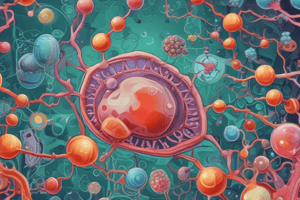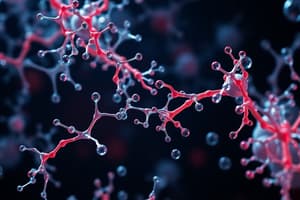Podcast
Questions and Answers
What is the primary purpose of centrifugation in cell fractionation?
What is the primary purpose of centrifugation in cell fractionation?
- To disrupt cell membranes and release organelles
- To extract proteins from cellular membranes
- To separate organelles based on their buoyant density (correct)
- To separate cells based on their size and density
What is the purpose of using marker enzymes in subcellular fractionation?
What is the purpose of using marker enzymes in subcellular fractionation?
- To separate organelles based on their size
- To determine the purity of subcellular fractions
- To identify specific organelles (correct)
- To extract proteins from cellular membranes
Which of the following is NOT a step in subcellular fractionation?
Which of the following is NOT a step in subcellular fractionation?
- Homogenization of cells
- Microscopy of cellular structures (correct)
- Centrifugation of cell lysate
- Extraction of proteins with solvents
What is the result of incomplete homogenization in subcellular fractionation?
What is the result of incomplete homogenization in subcellular fractionation?
Which of the following is a limitation of using centrifugation in subcellular fractionation?
Which of the following is a limitation of using centrifugation in subcellular fractionation?
What is the purpose of extraction in subcellular fractionation?
What is the purpose of extraction in subcellular fractionation?
Which of the following is NOT a type of centrifugation used in subcellular fractionation?
Which of the following is NOT a type of centrifugation used in subcellular fractionation?
What is the result of using a low speed centrifugation step in subcellular fractionation?
What is the result of using a low speed centrifugation step in subcellular fractionation?
What type of proteins are attracted to the positive functional groups in anion exchange chromatography?
What type of proteins are attracted to the positive functional groups in anion exchange chromatography?
What is the main purpose of using DEAE resin in anion exchange chromatography?
What is the main purpose of using DEAE resin in anion exchange chromatography?
In size exclusion chromatography, what happens to large proteins that cannot fit into the pores of the beads?
In size exclusion chromatography, what happens to large proteins that cannot fit into the pores of the beads?
What is the purpose of using a ligand in affinity chromatography?
What is the purpose of using a ligand in affinity chromatography?
How are bound proteins eluted from the column in affinity chromatography?
How are bound proteins eluted from the column in affinity chromatography?
What is the application of affinity chromatography in the medical field?
What is the application of affinity chromatography in the medical field?
What type of proteins move quickly down the column in anion exchange chromatography?
What type of proteins move quickly down the column in anion exchange chromatography?
What can be purchased with pores of a specific size range to accommodate proteins of a certain size?
What can be purchased with pores of a specific size range to accommodate proteins of a certain size?
What is the composition of the stationary phase in Cation Exchange Chromatography?
What is the composition of the stationary phase in Cation Exchange Chromatography?
What happens to proteins with a net positive charge in Cation Exchange Chromatography?
What happens to proteins with a net positive charge in Cation Exchange Chromatography?
What is the role of the Na+ ions in Cation Exchange Chromatography?
What is the role of the Na+ ions in Cation Exchange Chromatography?
Why do proteins with a large net positive charge remain stuck to the column?
Why do proteins with a large net positive charge remain stuck to the column?
How can proteins with a large net positive charge be eluted from the column?
How can proteins with a large net positive charge be eluted from the column?
What is the application of Cation Exchange Chromatography in water treatment?
What is the application of Cation Exchange Chromatography in water treatment?
What is the difference between Cation and Anion Exchange Chromatography?
What is the difference between Cation and Anion Exchange Chromatography?
What is the name 'Cation Exchange' referring to in Cation Exchange Chromatography?
What is the name 'Cation Exchange' referring to in Cation Exchange Chromatography?
Flashcards are hidden until you start studying
Study Notes
Biochemistry
- Biochemistry is the application of chemistry to the study of biological processes at the cellular and molecular level.
Introduction to Cell Structure
- The cell is the most basic unit of life.
- Animal and plant cells have variations in their structures.
- The module reviews various organelles within cells.
Learning Outcomes
- Define terms associated with cells.
- Describe the organelles found in all kinds of cells.
- Outline the function of each organelle.
- Outline the method used for fractionation and separation of cell components.
- Differentiate between the features of eukaryotic and prokaryotic cells.
Definitions
- Genome: the entire genetic complement of an organism, including all organic bases contained within the DNA, organized into 23 pairs or 46 chromosomes.
- Co-enzyme: an organic non-protein compound that binds with an enzyme to catalyze a reaction, can be reused several times.
- Pili: protein structures that extend from the bacterial cell envelope, function to attach cells to surfaces.
Chromatography
- Size Exclusion Chromatography:
- Stationary phase composed of microscopic cross-linked polymer beads with pores of a specific size range.
- Small proteins fit into the pores, while large proteins don't, resulting in separation based on size.
- Affinity Chromatography:
- Stationary phase composed of polymer beads with a ligand cross-linked to the beads.
- Proteins that bind to the ligand stick to the stationary phase, while others are washed off.
- Bound proteins can be eluted using a solution containing the ligand.
- Application: elimination of undesirable substances from blood.
- Ion Exchange Chromatography:
- Cation Exchange Chromatography:
- Stationary phase composed of microscopic polymer beads with negatively charged functional groups.
- Proteins with a net positive charge are attracted to the beads, while those with a net negative charge are not.
- Application: softening of hard water, demineralisation of water, and the separation and determination of anions.
- Anion Exchange Chromatography:
- Bead surface covered with positively charged groups.
- Cation Exchange Chromatography:
Studying That Suits You
Use AI to generate personalized quizzes and flashcards to suit your learning preferences.




